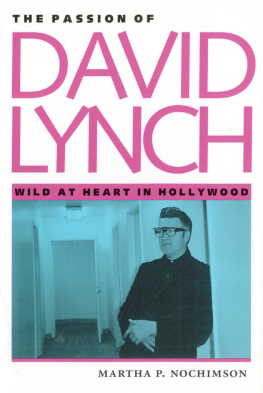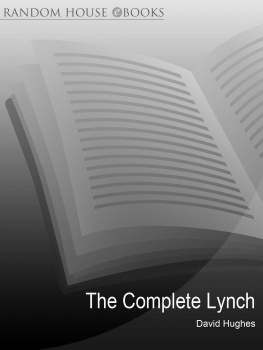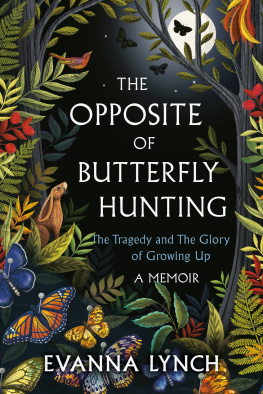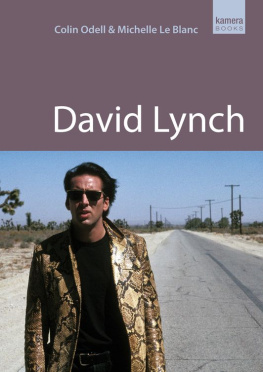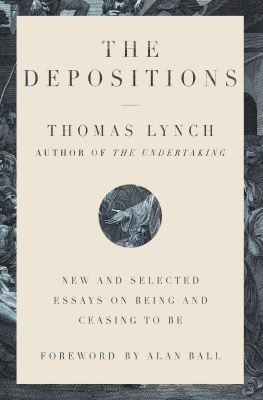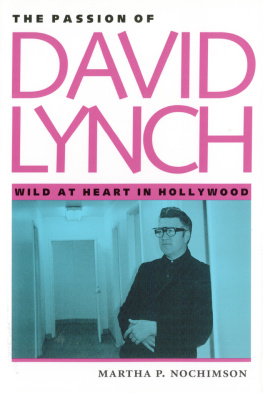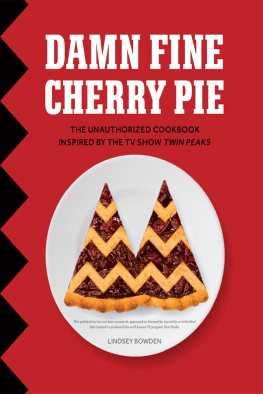The Passion of David Lynch
The Passion of David Lynch
WILD AT HEART IN HOLLYWOOD

Martha P. Nochimson

University of Texas Press
Austin
Copyright 1997 by the University of Texas Press
All rights reserved
Printed in the United States of America
Fifth paperback printing, 2005
Requests for permission to reproduce material from this work should be sent to Permissions, University of Texas Press, P.O. Box 7819, Austin, TX 78713-7819.
Library of Congress Cataloging-in-Publication Data
Nochimson, Martha.
The passion of David Lynch : wild at heart in Hollywood / by Martha P. Nochimson.
p. cm.
Includes bibliographical references and index.
ISBN 0-292-75565-1 (pbk. : alk. paper)
1. Lynch, David, 1946 Criticism and interpretation. I. Title.
PN1998.3.L96N63 1997
791.430233092dc21
97-7732
A list of follows the Index.
ISBN 978-0-292-79975-2 (e-book)
ISBN 978-0-292-74899-6 (individual e-book)
To know that balance does not quite rest,
That the mask is strange, however like.
WALLACE STEVENS,
The Man with the Blue Guitar
... there is a good ambiguity in the phenomenon of expression, a spontaneity which accomplishes what appeared to be impossible when we observed only the separate elements, a spontaneity which gathers together the plurality of monads, the past and the present, nature and culture into a single whole. To establish this wonder would be metaphysics itself and would at the same time give us the principle of an ethics.
MAURICE MERLEAU-PONTY,
The Primacy of Perception
List of Illustrations
Introduction
Coda
Appendix
Acknowledgments
As Jeffrey Beaumont tells Sandy Williams in Blue Velvet, There are opportunities in life for gaining knowledge and experience. Sometimes you have to take a risk. One opportunity is writing a book, requiring more than one risk but yielding extraordinary gains. Many people helped make the composition of The Passion of David Lynch: Wild at Heart in Hollywood a journey to places I had never been before, and I thank them.
First of all, thank you to David Lynch for the telling words, the miraculous silences, for rolling out the Hollywood welcome mat, and most of all for your work.
Thank you to Lynchs associates who spoke with me in a forthcoming and generous manner and often helped in many more ways than they knew: Michael John Anderson, Scott Cameron, John Churchill, Catherine Coulson, Duwayne Dunham, Julie Du-Vic, Frederick Elmes, Robert Engels, Simone Farber, Mark Frost, Ron Garcia, Cori Glazer, Richard Hoover, Toby Keeler, Rodger LaPelle, Dorothy McGinnis, Jack Nance, Deepak Nayar, Tina Rathborne, Peggy Lynch Reavey, Mary Sweeney, and especially to Gay Pope and Debbie Trutnik.
Thank you to the staff at the New York University Innovation Center, particularly Bill Horne, Joseph Hargitai, and Johannes LangPhotoshops of the World Unite!
Thank you to my students, academic colleagues, and friends who read, reacted, talked, and supported without necessarily agreeing: particularly Lynne and Josh Berrett, Sean Dugan, Sandy Flitterman-Lewis, Krin Gabbard, Adam Gooder, Bob Guttman, Darren Hopkins, Ann Martin, Anne McMahon, Lynne McVeigh, Carol Moore, Heather OLeary, Jonathan Rosenbaum, Ann Stetser, Sarah and Irwin Wall, the Mercy College Faculty Development Committee, and the Columbia University Film Seminar.
The author expresses appreciation to the University Seminars at Columbia University for assistance in the preparation of the manuscript for publication. Material drawn from this work was presented to the University Seminar on Cinema and Interdisciplinary Interpretation.
Thank you to Hyperion Books for supplying me with a copy of Images. Thank you to Bruce Phillips of Canton, Michigan, and his catalogue, Twin Peaks Collectables, for his stock of Lynchiana that served as such a valuable resource.
Thank you to Ali Hossaini, Jim Burr, and all those at the University of Texas Press who proffered their confidence and counsel.
Finally, mad love and gratitude to my family: my dearest, insightful husband Richard, and my precious children, David and Holly, who must have met the Good Witch; they seem to know what it means to be truly wild at heart.
THE PASSION OF DAVID LYNCH
Introduction
David Lynch at a (Feminine) Glance, or Her Eyes Were Moving, but She Didnt Know It
The comedy of hollow sounds derives From truth and not from satire on our lives.
WALLACE STEVENS
When I began writing this book, I thought I knew my direction, but much changed after a series of encounters with David Lynch. These meetings started with an intense half-hour phone call on January 31, 1992. A year later, March 29April 1, 1993, I made a series of daily visits to his studio offices in Los Angeles to interview him. In 1996, I observed him directing on the set of Lost Highway (January 1518) and subsequently met him in New York on March 13, and again in Los Angeles on April 12, to hold the conversations for which there had been no time in the hurly-burly of production. Our early meetings confounded many of my expectations, especially of what Lynch would clarify for me about his manner of representing reality in movies. Our later meetings brought both more finely detailed nuances to the revelations of our first encounters and still more revelations.
Before I met Lynch, the prospect of speaking with him filled me with the anticipation of acquiring knowledge. I would fill in the gaps of a picture already sketched in my mind. I would get an enormously precious something, which I would transmit in my book. As it turned out, much of the value of my time with David Lynch came as a result of letting go. The core of my vision as a film critic is a distinctly feminist dissatisfaction with what Hollywood films generally present as reality, particularly regarding the representation of masculinity and femininity. I have in no way surrendered my dissatisfaction, but I have relinquished some old conceptions about gender issues, Lynchs work, and Hollywoods potential for realism.
First, I had to let go of the customary identification of Lynchs work with that of Joel and Ethan Coen (Barton Fink, 1991), Peter Greenaway (Drowning by Numbers, 1988), David Mamet (House of Games, 1987), Neil Jordan (Mona Lisa, 1986), and David Cronenberg (Naked Lunch, 1991). All of these filmmakers reveal the labyrinthine self-referentiality of narrative; all despair, in varying ways, of representing any reality beyond that of structure. They may share with Lynch a vibrant distrust of the mimetic illusions of conventional Hollywood realism, but, as my time with Lynch revealed, seminal differences exist that make comparisons relatively trivial.
I also had to let go of some of my presuppositions about realism in Lynchs representation of women. I had thought that, for the most part, Lynch had eliminated realism from his films in a way that deconstructs Hollywoods images of women and men and thus intersects with some feminist attitudes. But how does one venture this kind of analytic statement with a director who has already declined to pass judgment on whether, in the final cut of his own Wild at Heart, Marietta was represented as loving her daughter Lula? Diane [Ladd, portraying Marietta] thought she did, he said. Dont film directors control these details? I wondered, as my argument about gender representation floated away.

